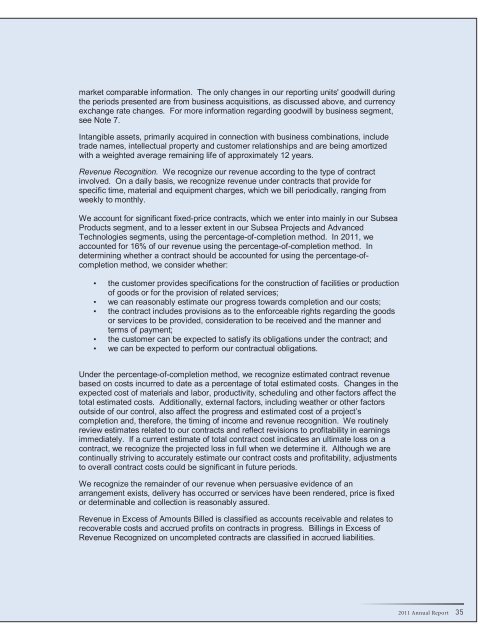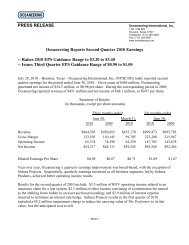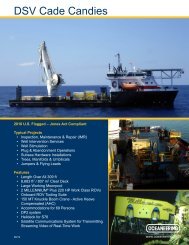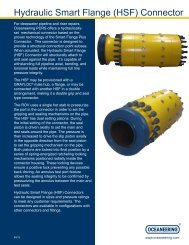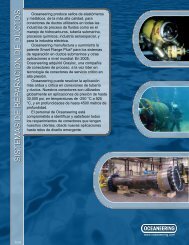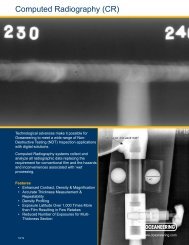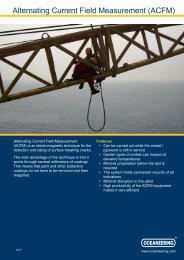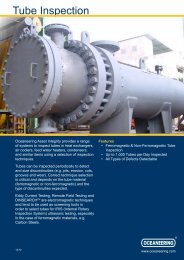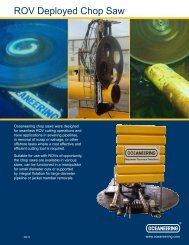segment and its Australian assets and operations are in our Subsea Projects segment.Our consolidated results of operations on an unaudited pro <strong>for</strong>ma basis, as thoughAGR FO had been acquired on January 1, 2010, are as follows:(in millions, except per share figures) 2011 2010Pro <strong>for</strong>ma revenue $ 2,385.6 $ 2,094.0Pro <strong>for</strong>ma net income 239.5 200.8Pro <strong>for</strong>ma diluted earnings per share 2.20 1.83The above amounts are based on certain assumptions and estimates that we believe arereasonable. The pro <strong>for</strong>ma results reflect events occurring as a direct result of thepurchase and do not necessarily represent results which would have occurred if theacquisition had taken place on the basis assumed above, nor are they indicative of theresults of future combined operations.On December 27, 2011, we purchased Mechanica AS, a design and fabrication companyspecializing in remotely operated subsea tools <strong>for</strong> the offshore oil and gas industry, <strong>for</strong>$17 million. We have accounted <strong>for</strong> this acquisition by allocating the purchase price tothe assets acquired and liabilities assumed based on their estimated fair values at thedate of acquisition. Our goodwill, all nondeductible <strong>for</strong> income tax purposes, associatedwith the acquisition was $9 million, and other intangible assets were $5 million. Thispurchase price allocation is preliminary and based on in<strong>for</strong>mation currently available tous, and is subject to change when we obtain final asset and liability valuations. As weacquired Mechanica AS late in December 2011, its results of operations are included inour consolidated statements of income from the date of acquisition, but the 2011 resultswere not material.We also made several smaller acquisitions during the periods presented.Except <strong>for</strong> AGR FO, the above acquisitions were not material. As a result, we have notincluded pro <strong>for</strong>ma in<strong>for</strong>mation related to those acquisitions in this report.Goodwill and Intangible Assets. In September 2011, the FASB issued an updateregarding goodwill impairment testing. Under the update, an entity has the option to firstassess qualitative factors to determine whether the existence of events or circumstancesleads to a determination that it is more likely than not that the fair value of a reporting unitis less than its carrying amount. Our reporting units are the operating units one levelbelow our business segments, except <strong>for</strong> ROVs and Asset Integrity, which are tested assingle reporting units. If, after assessing the totality of events or circumstances, an entitydetermines it is not more likely than not that the fair value of a reporting unit is less thanits carrying amount, per<strong>for</strong>ming the two-step impairment test is unnecessary. However, ifan entity concludes otherwise, then it is required to per<strong>for</strong>m the first step of the two-stepimpairment test. This update is effective <strong>for</strong> us January 1, 2012, and earlier adoption ispermitted. We have elected to adopt this update early and we applied it in 2011. Theprovisions of the update have not had a material effect on our financial position or resultsof operations. We tested the goodwill attributable to each of our reporting units <strong>for</strong>impairment as of December 31, 2010 and 2009 and concluded that there was noimpairment. We estimated fair value using discounted cash flow methodologies and34 <strong>Oceaneering</strong> International, Inc.
market comparable in<strong>for</strong>mation. The only changes in our reporting units' goodwill duringthe periods presented are from business acquisitions, as discussed above, and currencyexchange rate changes. For more in<strong>for</strong>mation regarding goodwill by business segment,see Note 7.Intangible assets, primarily acquired in connection with business combinations, includetrade names, intellectual property and customer relationships and are being amortizedwith a weighted average remaining life of approximately 12 years.Revenue Recognition. We recognize our revenue according to the type of contractinvolved. On a daily basis, we recognize revenue under contracts that provide <strong>for</strong>specific time, material and equipment charges, which we bill periodically, ranging fromweekly to monthly.We account <strong>for</strong> significant fixed-price contracts, which we enter into mainly in our SubseaProducts segment, and to a lesser extent in our Subsea Projects and AdvancedTechnologies segments, using the percentage-of-completion method. In 2011, weaccounted <strong>for</strong> 16% of our revenue using the percentage-of-completion method. Indetermining whether a contract should be accounted <strong>for</strong> using the percentage-ofcompletionmethod, we consider whether:• the customer provides specifications <strong>for</strong> the construction of facilities or productionof goods or <strong>for</strong> the provision of related services;• we can reasonably estimate our progress towards completion and our costs;• the contract includes provisions as to the en<strong>for</strong>ceable rights regarding the goodsor services to be provided, consideration to be received and the manner andterms of payment;• the customer can be expected to satisfy its obligations under the contract; and• we can be expected to per<strong>for</strong>m our contractual obligations.Under the percentage-of-completion method, we recognize estimated contract revenuebased on costs incurred to date as a percentage of total estimated costs. Changes in theexpected cost of materials and labor, productivity, scheduling and other factors affect thetotal estimated costs. Additionally, external factors, including weather or other factorsoutside of our control, also affect the progress and estimated cost of a project’scompletion and, there<strong>for</strong>e, the timing of income and revenue recognition. We routinelyreview estimates related to our contracts and reflect revisions to profitability in earningsimmediately. If a current estimate of total contract cost indicates an ultimate loss on acontract, we recognize the projected loss in full when we determine it. Although we arecontinually striving to accurately estimate our contract costs and profitability, adjustmentsto overall contract costs could be significant in future periods.We recognize the remainder of our revenue when persuasive evidence of anarrangement exists, delivery has occurred or services have been rendered, price is fixedor determinable and collection is reasonably assured.Revenue in Excess of Amounts Billed is classified as accounts receivable and relates torecoverable costs and accrued profits on contracts in progress. Billings in Excess ofRevenue Recognized on uncompleted contracts are classified in accrued liabilities.2011 Annual Report 35
- Page 3 and 4: Financial Highlights($ in thousands
- Page 5 and 6: In December we secured a three-year
- Page 7: 2011 Financial SectionOceaneering I
- Page 10 and 11: Oceaneering Common StockOur common
- Page 12 and 13: Management's Discussion and Analysi
- Page 14 and 15: Critical Accounting Policies and Es
- Page 16 and 17: We establish valuation allowances t
- Page 18 and 19: In 2009, we used $162 million in in
- Page 20 and 21: For 2011, our ROV revenue and opera
- Page 22 and 23: We earn equity income from our 50%
- Page 24 and 25: Controls and ProceduresDisclosure C
- Page 26 and 27: In our opinion, Oceaneering Interna
- Page 28 and 29: OCEANEERING INTERNATIONAL, INC. AND
- Page 30 and 31: OCEANEERING INTERNATIONAL, INC. AND
- Page 32 and 33: OCEANEERING INTERNATIONAL, INC. AND
- Page 34 and 35: for marine services equipment (such
- Page 38 and 39: Revenue in Excess of Amounts Billed
- Page 40 and 41: elationship and, if it is, the type
- Page 42 and 43: December 31,(in thousands) 2011 201
- Page 44 and 45: in entities or jurisdictions that h
- Page 46 and 47: 4. SELECTED BALANCE SHEET AND INCOM
- Page 48 and 49: On January 6, 2012, we entered into
- Page 50 and 51: Financial Instruments and Risk Conc
- Page 52 and 53: The table that follows presents Rev
- Page 54 and 55: The following table presents Assets
- Page 56 and 57: Geographic Operating AreasThe follo
- Page 58 and 59: equirements. The Compensation Commi
- Page 60 and 61: in 2011, 2010 and 2009 were subject
- Page 62 and 63: Forward-Looking StatementsAll state
- Page 64: Oceaneering International, Inc.1191


